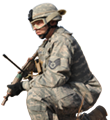Army National Guard Aviation Soldiers from New York, Maine, and Connecticut Train for Deployment
| DMNA Home page | More News Stories |
Story by: Master Sgt. Peter K. Towse - 42nd Infantry Division
Dated: Thu, Sep 22, 2011
FORT DRUM, NY -- More than 400 Army National Guard Soldiers from the 42nd Combat Aviation Brigade , and other New York Army National Guard aviation elements, are training here to prepare Soldiers for a potential deployment overseas in 2012.
New York National Guard Soldiers from the 3rd Battalion, 142nd Aviation Assault Helicopter Battalion based on Long Island are joined with elements of the New York’s Company B, 3rd Battalion, 126th Aviation from Rochester and detachments from both the Connecticut and Maine Army National Guard for the training. The troops are conducting individual pre-mobilization training tasks that are required before individual deployment overseas.
The rotation of forces has over 400 Soldiers on the ground at Fort Drum for the pre-mobilization training, with another 200 Soldiers from across the state providing training support, instruction, logistical support and administration of the entire scenario.
"Very comprehensive and well-rounded training," said Chief Warrant Officer Tom Richmond, a native of Hudson, Maine and a Blackhawk pilot with Detachment C, Company E, 3-142. "This will prepare us for theater operations."
The training, called the 15-4 (15 individual tasks and four team tasks), includes basic Soldier tasks such as land navigation, recognition and reaction to improvised explosive devices, first aid, conduct convoy operations, weapons training and specific skill-related tasks for military police, logistics, medical and other tailored forces.
"We teach basic Soldier skills to give everyone a solid foundation before they deploy," said Sgt. Adam Drobecker, a trainer with the pre-mobilization training assistance element (PTAE). "There is always the possibility of getting into a fire fight and every Soldier needs to learn and perform to keep themselves, and their buddy, alive." The PTAE conducts all the training and evaluates the unit conducting the training prior to the unit mobilizing.
"This training is a real good refresher," said Private First Class Juan Maldonado, an aviation operations specialist with Headquarters and Headquarters Company, 3rd Battalion, 142nd Assault Helicopter Battalion. It is the best training, by far, added the Bronx, NY native.
Once the classes and practice phases are complete, the Citizen Soldiers take on what is commonly referred to as the fight lane.
"The fight lane is a culmination of all the tasks they have learned up to that point for one, final event," said Command Sgt. Major Anthony Mclean, the Command Sgt. Major of the PTAE. "The Soldiers move through an urban training site and interact with civilian role players, using an interpreter for negotiations with the mayor of the town. They then move as a member of a fire team, react to sniper fire and conduct combat actions. They also have to enter and clear buildings, capture and search personnel and maneuver through obstacles."
Part of the dismounted (no vehicles) fight lane is the mud pit ... A water and mud-filled area that all the troops have to drudge through while low crawling under concertina wire and taking fire from role playing enemies hidden in buildings surrounding the pit. Mud-soaked, the team members help each other through more razor wire and over the walls of the town while communicating over the artillery simulated explosions and through the dense smoke grenades.
"There is chaos, then there is controlled chaos," Drobecker said. "The difference between the two is being able to communicate while under fire and making sure everyone is doing what they are supposed to be doing in order to successfully meet the objective."
The overall effort of the pre-mobilization training began on September 12 and will continue through September 25.
"The training continues to go very well," said Lt. Col. Mark Slusar, commander of the 3rd-142nd. "The Soldiers are motivated and the training is very realistic."
"Any time Soldiers can get a basic understanding of what to expect when going overseas, is good training," said Brig. Gen. Mark Russo, the Assistant Adjutant General for the Connecticut National Guard. "I have been to many training sites and this is one of the better training exercises that I have seen."
URL: https://dmna.ny.gov/news/?id=1316719686
216.73.216.183
Page Last Modified: Thu, Sep 22, 2011




